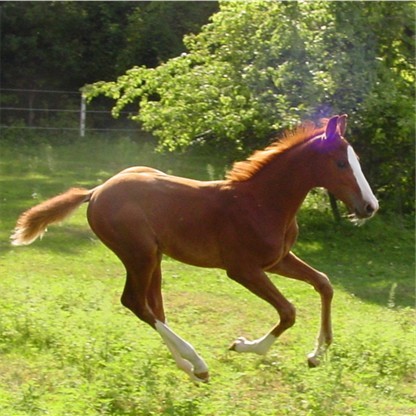Feeding Weanlings

You have followed your preferred method for weaning foals and you have followed the directions below:
- You made certain that the foals were consuming at least 1 pound of a feed per month of age of a feed designed for foals and weanlings. 6 month old foals were consuming 6 pounds of feed per head per day.
- Appropriate feeds will be 14-16% protein with controlled starch and sugar along with amino acid, mineral and vitamin fortification designed for young growing horses.
- You kept in mind that past 2 months of age, the milk produced by the dam was not sufficient to maintain adequate growth, so the foals were creep fed if possible as not all mares allow the foal to eat with them. The foal also had access to high quality forage, loose salt and fresh, clean water.
- You made certain that the foals were vaccinated for appropriate diseases and de-wormed according to your health care plan. Vaccination is a stress on the animal, so you did not do this at the same time you weaned the foals
- The foals have been handled, taught to lead and have had their feet trimmed.
Now What?
You need to monitor the weanlings/early yearlings fairly closely and adjust feed intake to maintain desired growth rate and healthy body condition, feeding according to both weight and Body Condition Score (BCS).
- Weanlings at 6 months of age that will mature at 1200 lbs. may be gaining 1.5+ lbs. per head per day.
- The objective should be to maintain a smooth and steady rate of growth and a BCS of about 5.
Why Does My Weanling Have a Pot Belly?
Some weanlings become a bit pot-bellied, do not gain muscle mass and look a little rough following weaning. This is frequently due to inadequate concentrate feed intake and too much forage. The cecum is NOT fully developed in the weanling, so it cannot digest forage as efficiently as an older horse.
If a young growing horse is not getting the essential amino acids from a well-balanced concentrate, muscle development is slowed down. If it is not getting the appropriate minerals, the risk of developmental orthopedic problems may increase.
How MUCH Should You Feed a Weanling?
A 6 month old weanling may be consuming 2.0-3.5% of bodyweight in feed and hay per day as fed and should be consuming about 70% concentrate and 30% forage. At 12 months of age, the growth rate will slow down to about 1-1.25 lb. per day and the yearling will be consuming about 2.0-3.0% of bodyweight in feed and hay per day as fed and the concentrate to forage ratio will drop to 60:40.
As the young horse grows, the rate of growth slows down and the amount of forage it can digest efficiently increases. Digestible Energy (DE) intake drives growth, but requires the right balance of amino acids and minerals to achieve healthy growth. Too much DE without the right balance might lead to excessive BCS (fat!) with lack of muscle gain and may increase risk potential developmental orthopedic issues.
Proper preparation can minimize the stress of weaning for foals and help maintain uniform growth and body condition in the weanling to yearling transition to help develop a sound equine athlete.
